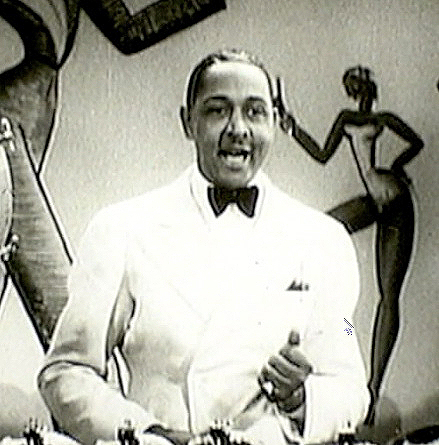View/Download PDF
Introduction
Throughout the 1930s and 1940s, the three major studios, MGM, Warner Bros., and Paramount, each had special units devoted to the production of musical short subjects. Columbia, RKO, Fox and Universal — the so-called “minor majors” — produced many short subjects “in house,” but also contracted with others to put together shorts for them, especially their musical/variety one-reelers.
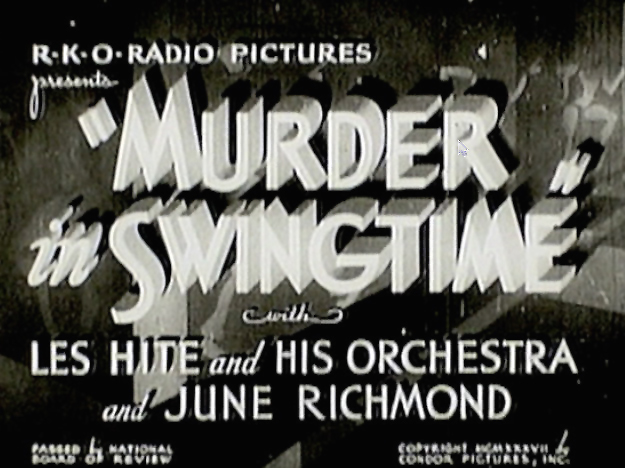
During the 1930s, RKO relied on Milton Schwarzwald’s Nu-Atlas Productions for many one reel musical shorts. Between 1937 and 1939, Schwarzwald churned out more than twenty short subjects, exclusively one reelers (ten minutes), in the musical/variety genre. But the need for regular, high quality content eventually led RKO to other producers, including George Hirliman. Hirliman was, for the most part, a fringe producer in Hollywood, and such exploitation films as REEFER MADNESS can be laid at his feet. In 1937 Hirliman hired director Arthur Dreifuss, a German expatriate, to produce a series of short subjects, all under the banner of a Hirliman subsidiary Condor Productions. The first of these films, MURDER IN SWINGTIME, is one of the more imaginative and better-directed independent musical shorts from the 1930s, highly deserving of in-depth research, and the discussion that follows.
Arthur Dreifuss
German-born Arthur Dreifuss was a prolific filmmaker who spent much of his life working on Poverty Row, directing short subjects, SOUNDIES, ethnic films and “B” features for the likes of Columbia, Monogram, PRC and others. In a lengthy videotape interview conducted in his Studio City home in 199O, Dreifuss commented, “I never had a lot of money to do my films. So, I just substituted any talent that I had with a lot of planning. A lot of the time, well, that planning shows up on screen, it’s what makes things work for the film.”
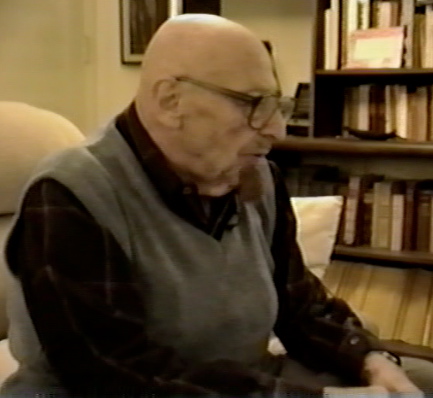
Dreifuss had emigrated to the United States in 1928, where he was soon working on Broadway, first as a dance director, and later as a producer. His comfort with dance and musical performance led to a career that concentrated to a great extent on musicals, or at least films that included music in one way or another.
Dreifuss abandoned Broadway and moved to Los Angeles in the late 1930s. “When I first got to Hollywood, I worked as a dance director, a lot of the time uncredited. I did some films for an independent filmmaker name [George] Hirliman. He had a vision for what he wanted on screen, but not a lot of money. That was a problem that I often encountered … lots of vision, not much money. But I planned hard and sometimes it worked out, sometimes not. Some of the things I did later for Sam Katzman — he was as cheap as they came — made a lot of money. THE LOVE IN and RIOT ON SUNSET STRIP … not great movies, but fun films, and moneymakers, too. The film I am proudest of is THE QUARE FELLOW, from a play by Brendan Behan. We had Patrick McGoohan and Sylvia Sims.” MURDER IN SWINGTIME, the subject of this article, was the first in his long list of directorial efforts.
The Plot
The story and dialogue for this film were put together by Eda Edson, a writer whose work was supported at the time by the WPA (Works Projects Administration). “She was doing work for the government around this time, some interesting projects,” claimed Dreifuss, “ but I don’t recall how she came to this film. This wasn’t a government thing at all, just a little short that I was asked to direct, she was called on to write.” Edson had a musical background, and was acquainted with the films musical director, Ross DiMaggio, and it is possible that DiMaggio brought her to the attention of Dreifuss or Hirliman.
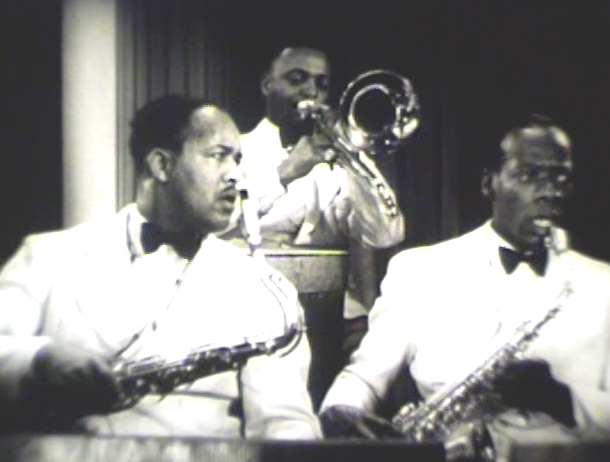
The short opens in a nightclub, where Les Hite and his Orchestra entertains a black audience. His singer is June Richmond, who shares a featured song by Jac Dale titled, “What’s Music Got?” The Rhythm Pals then perform a tap dance to the song …. but something is amiss. Two of the saxophone players have nefarious plans: “Thinking of pulling it tonight, ain’t ‘cha?,” says tenor saxophonist Charlie Jones. “Yeah,” says actor Charles Andrews,” pointing down to a closed music case.
The song ends, and Les Hite announces that the band will now play a “swingphonic arrangement of an old favorite, Dinah. Yowsuh!” This seems to be the key to the conspiracy because Jones comments, “It won’t be long now” The music begins, and in the midst of the first chorus, Andrews picks up a piccolo, begins playing random notes and is hit on the head by trombonist Sonny Graven. “There’s been a murder committed,” a voice off screen announces. “Someone has just murdered Dinah.” The band is arrested, and the scene shifts to “Night Court.”
The judge begins the proceedings, speaking in rhyme, as do the two members of the jury. The suspects, the entire Les Hite orchestra, are brought into the courtroom. Now, each in turn, a number of soloists from the orchestra are called upon to solo for the jury, each playing Dinah: Joe Fiddle, Benny Clarinet (Marshall Royal), three saxophones playing is a sweet Lombardo-style; and Louis Trumpet (George Orendorff). All are pronounced “not guilty,” and the prosecutor declares that Hite must be the guilty one! Hite is willing to take the rap, but then Andrews steps forward, confessing to the crime. The judge proclaims that he must “swing.” But as he protests, he is awakened, and we are back in the night club. An extended version of Dinah commences, with a group of female chorus line dancers performing in front of the band, as the short ends.
Frank Sebastian’s New Cotton Club
When asked about the musical talent engaged for the short, Dreifuss explained, “This was a short that was to feature all Negro talent. We knew that from the start. There were a number of places where we could hire the musicians, and a friend, he was working at either Metro (MGM) or Roach (Hal Roach), I think, pointed us to the Cotton Club in Culver City (Frank Sebastian’s New Cotton Club.) Les Hite’s band was featured there, and we hired the band, and the chorus line dancers, too.”
Built in 1923, and opening as The Green Mill, the nightclub was originally a speakeasy located at 65OO Washington Blvd., in Culver City. Three years later it was purchased by nightclub owner and entrepreneur Frank Sebastian, who had earlier run a nightclub in Venice, some five or six miles to the west. Rechristened The Cotton Club (alternately Frank Sebastian’s Cotton Club, and ultimately Frank Sebastian’s New Cotton Club), the venue offered the best in black entertainment for more than a decade. Floor shows, jazz soloists, the finest vocalists, great jazz bands …. all this could be seen on stage in Culver City. Among the stellar performers who graced the stage were Louis Armstrong, Cab Calloway, Fats Waller and, of course, Les Hite and his Orchestra. The nightclub was segregated and only whites could view the floorshow and partake of the dancefloor.
An Internet site hosted by Martin Turbull quotes the daugter of a visitor to the club during the 1930s: “It was a hottie-bawdy place, and my relatives all loved and talked about the wild times there for years after. Duke Ellington, Cab Calloway, some wonderful dancing revues and the great Louis Armstrong played there often. Frank Sebastian apparently had a club first in Venice on Windward, closed that when he opened the Cotton in Culver. It was HUGE in size and in entertainment. Mom said it was the kind of place you could dance right through the souls of your shoes!”
Frank Sebastian’s New Cotton Club closed its doors in 1938, although it soon reopened as The Casa Mañana, and later the famed Meadowbrook Ballroom.
The Performers
Les Hite and his Orchestra
The Les Hite orchestra had been a fixture on the Los Angeles music scene since the early 193Os. Louis Armstrong had fronted the band in 193O for an engagement at Frank Sebastian’s New Cotton Club in Culver City. Early in the year Armstrong recorded eight titles with the band, over three recording dates. This was also the orchestra that appeared with Louis in the now-legendary (and presumed lost) film EX-FLAME) (Liberty Pictures/Tiffany, 1930). While the band recorded for ARC later in the decade, those sides remain unissued. Les Hite’s band, or contingents from it, also appear in many films, and I have been able to trace more than twenty in the decade beginning in 193O.
The Les Hite orchestra had a fairly stable personnel during the 193Os, this due to Hite’s ability to consistently find work for the band. An early identification of the sidemen in this short was circulated many years ago by Theo Zwicky. A few of Theo’s suggestions were questioned by Gerald Wiggins and Buddy Collette. For final measure, I sent freeze frames to Peter Vacher, an expert on the Los Angeles jazz scene during this period. We can be fairly confident of the following, with a few caveats noted after the listing:
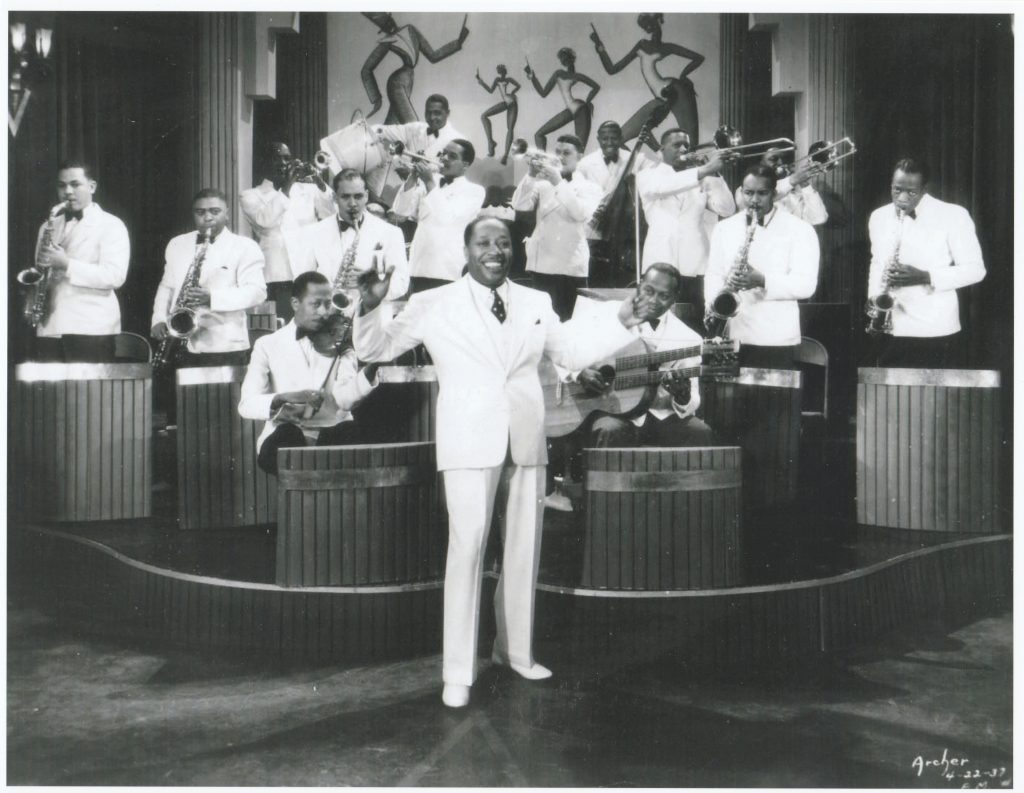
Leader: Les Hite
Trumpets, left-to-right: James “King” Porter, Lloyd Reese or Howard Scott, George Orendorff
Trombones, left to right: possibly Parker Berry, Luther “Sonny” Graven
Reeds, left-to-right: Marvin Johnson, Paul Howard, Marshall Royal, Charles Jones, Charlie Andrews
Violin: unidentified
Piano: Henry Prince
Guitar: Bill Perkins
String bass: Joe Bailey
Drums: Peppy Prince
Charlie Andrews, seen on tenor sax to the far right, was not a member of the band. His presence is noted by the California Eagle, and it is possible that he is not a musician, and was just hired to fill out the saxophone section and move the the story forward
While Theo Zwicky suggested Lloyd Reese as the middle trumpet, Peter Vacher feels that it is definitely Howard Scott. “Could be so,” commented Buddy Collette.

The musician who plays “Joe Violin” is also a problem. Both Buddy Collette and Gerald Wiggins were certain that he was not a regular member of the band. Jazz violin expert Anthony Barnett notes, “It looks to me as if he really is a violin player – what he does finger and bow-wise matches perfectly what is heard on the sound track, whether or not the man on screen is the man heard on the soundtrack. This is most frustrating because he does sound so good. Apart from Atwell Rose (who is not on screen and I do not think off screen either), another recorded violinist in LA was Roland Bruce (with Reb Spikes in 1927). A picture of a musician who may be Bruce can be seen at: http://library.umkc.edu/speccol/local627/photos/bands/lewis/mmf-p109.htm
June Richmond
June Richmond is a superior jazz singer, well-versed in the blues, and always swinging! She emigrated to Europe in 1948 and that possibly accounts for her relative obscurity today. Various printed and online sources, seemingly quoting each other, note that Richmond worked with Les Hite during this period. It is unclear whether or not they are referring to this movie, or if there is evidence that she appeared with Hite at the Cotton Club. In any case, Richmond was with Jimmy Dorsey for at least six months in March-July 1938, one of the first black singers to appear on stage with a white jazz band. She appears on six recordings with the band, and presumably broadcast with the band on its many remotes from this period.
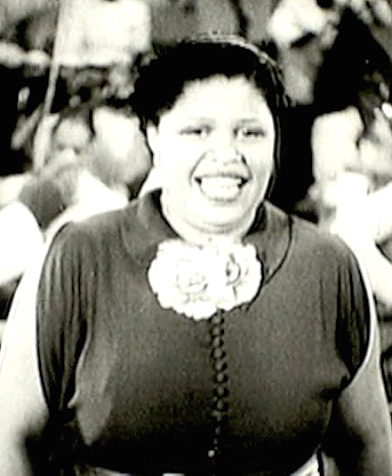
After a short stay with Cab Calloway (two recordings in March 1939), June joined Andy Kirk for a fruitful six year period. She recorded frequently with the band, and enlivens each appearance. During this period she also appeared on screen on a number of occasions: SOUNDIES with Roy Milton, and under her own name; a black cast feature with Louis Jordan; and a fabulous vocal chorus in CAROLINA BLUES (Columbia, 1943), in which she joins Harold Nichaolas the Step Brothers, Kay Kyser and others in the “Mr. Beebe” production number.
MURDER IN SWINGTIME is June’s earliest screen appearance, and she is featured in the number that opens the short, presented as portion of a night club routine. She is in fine form, and despite the relatively banal quality of the song, one questions why she did not gain greater fame during this period.
The Rhythm Pals
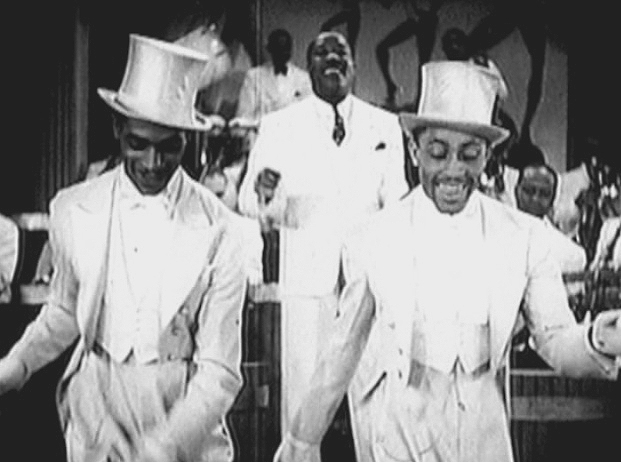
The Rhythm Pals, a pair of fine tap dancers, are featured briefly in the opening number, following June Richmond’s vocal. In a telephone interview in the mid 1990s, dancer Cholly Atkins, one of the fabled names in jazz dance, identified his partner as Bill Porter. He had little to say about Porter, however, and did not know what became of him after the team broke up ca. 1938. Atkins, of course, went on to great fame as a member of the team Cole and Atkis, which appeared on broadway (Gentlemen Prefer Blonds), as well as on televsion and in person with Louis Armstrong, Count Basie, Lionel Hamton and others. Later in his career he served as a choreographer for artists appearing on Motown Records.
The Sideline Extras
 |
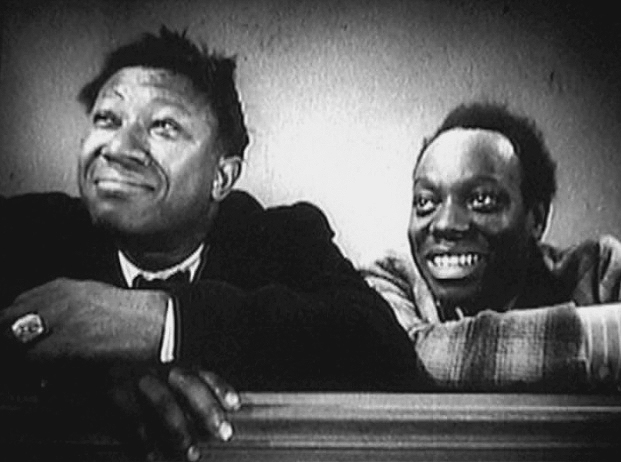
Arthur Dreifuss commented about the sideline extras used in the nightclub and night court scenes: “We were white filmmakers, and we didn’t have a lot of connections among the Negro community. So we had someone from Central Avenue help us with the casting. We couldn’t afford real big talent. Someone like Nick Stewart, he was a big star then, he was out at Fox. Couldn’t afford him. Don’t forget, we had very strict segragation in town, so we had to go with this agent.
“We didn’t have enough money for twelve jurors, so we used three [sic – actually, two). We used the rest of the cast for the crowd scene in the courtroom. We filmed this over a couple of days, and we paid the actors as much as we could.” Ironically, although Dreifuss could not recall the name of the agent, he did spot him on screen, in the shot of the two jurors: “The one on the right, now he was a comedian and an agent. He helped us get the non-musical members of the cast.”
The Chorus Girls
The members of the chorus line, who appear in the closing segment of the short, were all members of the floorshow at the Cotton Club. An article in the California Eagle identifies them as Lois Bright, Connie Harris, Rosa Lee Lincoln, Patsy Hunter, Mildred Boyd, Louise Robinson, Ethel Boyd, Catherine Atkinson,. (It might be noted that Lois Bright appears a decade later in the black cast feature Hi-De-Ho (All-American News, 1937), as a member of the dance trio Miller Brothers and Lois.
The Production
While George Herliman, and his subsidiatry, Condor Pictures, had offices at Grand National Pictures, contemporary press reports suggest that the short was produced down the street, still on Sunset but ten blocks east west, at Conn Studios. Why the film was filmed on rental stages at Conn, rather than Grand National, is one of those factoids lost to time.
Production of the film took place in April 1937. The recording session was probably a day-long affair, sometime in the first three weeks of the month. A copy of the shooting script kept by Mack Stengler, the cinematographer, notes that the filming of the entire short was completed in two days, April 22-23, 1937.
A few words about cinematographer Mack Stengler: Stengler had an astonishing career lasting from the late silent era through the first Goldgen Age of Television. He was the cameraman on the Jack Benny Show, Leave It To Beaver and many others. While Stengler mostly worked on “B” pictures, his professionalism can be seen in every film that he made. His six page shooting script for this short is meticulous, specifying each shot for the film. Dreifuss notes, “The cameraman and I had everything planned in advance, so we were able to get the filming done in one or two days. I always laid my shots out before hand. Didn’t storyboard, but I knew what I was doing. After that, I was there, directing when the work [editing] was done in the cutting room.”
Dreifuss continues, “I recall it being an easy shoot. I think that Ross DiMaggio, the musical director, he did the arrangements, but the guys in the band didn’t have any trouble with them. Of course, they all knew the tune Dinah. These guys were so comfortable at the fiming session, and that’s why they feel so natural on screen.”
The Music
Two songs are featured in the short. The first, “What’s Music Got?” by Jac Dale was likely written for the film. It was not recorded at the time, and I cannot find any mention of Dale online, or in any of the books at my disposal. “Dinah,” on the other hand, is the well known standard by Sam Lewis, Joe Young and Harry Akst.
(1) Dinah (behind credits, into nightclub scene) – Les Hite and his Orchestra (no soloists, but Marshall Royal’s clarinet is heard prominently above the band)
(2) What’s Music Got? – Les Hite and his Orchestra – Les Hite (vocal introduction) + June Richmond, vocal + The Rhythm Pals , dance (soloists: unidentified trumpet, straight)
(3) Dinah – whistling by Les Hite, vocal by Peppy Prince, interrupted by the “murder” committed by Piccolo Pete, who is then knocked unconcsious by trombonist Sonny Graven.
(4) At the trial, four brief excerpts are played by members of the band as they are called to the stand to testify:
- 1. Dinah (16 bars) – unidentified violin (as “Joe Violin”)
- 2. Dinah (16 bars) – Marshall Royal, clarinet (as “Benny Clarinet”)
- 3. Dinah – song’s release, 8 bars – reed section, in sweet, Lomnbardo-syyle arrangement
- 4. Dinah (8 bars) – George Orendorff, trumpet
- 5. Dinah – concluding floor show version (soloist: Marhall Royal clarinet, not seen on screen)
The Reviews
Two reviews can be found for this short, one from the white press, the other from the black press. As one might expect, the white reviewer is quite dismissive of the short, the black writer quite lauditory.
Motion Picture Exhibitor, September 1, 1937:
“Les Hite leads his band, and various soloists strut their stuff. When one of the band tires of hearing Dinah, he produces a piccolo, “murders” the song. Hauled into night court, the musicians are made to play Dinah on their respective instruments to determine who did the killing. It turns out to be a dream of one of the musicians. June Richmond does the vocal soloing. Whole cast is Negro, music is all in the very hot Negro style; neither the principals nor the inane story will appear. FAIR.”
California Eagle (reviewed by Harry Levette) on May 13, 1937.
“Of all musical shorts turned out in the Hollywood and New York Movietone Studios, “Murder In Swingtime,” filmed last week by Les Hite and his band, is predicted to grab off the Croix de Guerre with the double palm. It was made at the Conn Studios on Santa Monica boulevard in Hollywood. The piece is as unique as its name, and instead of being a pot-pourri of tunes as a excuse for the band to play, it has a definite plot that moves along on the waves of music until the unexpected climax.”
Evaluation
For those of us who enjoy straight musical performances on screen, unfettered by story or dialogue, this film will prove somewhat of a disappointment. Indeed, because of the rather convoluted story, the jazz content is a bit limited. Despite the intrusion of the story, however, we do have a fine June Richmond vocal, some dance by both The Rhythm Pals and the Cotton Club chorus girls, and some fine solo statement by Marshall Royal, George Orendorff and an unidentified violinist.
Looking a bit deeper at the film, one has to be impressed by the vision that director Arthur Dreifuss brought to the short, and the ability of the musicians, non-actors all, to make the story work on screen. This is certainly not the first short in which music is framed in a story, but it is one of the most successful in terms of black cast films. The story, if not original, is cute and compelling, the acting natural, and the music swinging. There are no references to watermelons, straight razors, fried chicken or any of the other images that marr earlier films.
The joy of watching this film with director Arthur Dreifuss is somthing one can only imagine. If my memory serves me correctly, it was the first time he had seen the film in more than fifty years. Some final comments from Arthur serve to sum things up:
“I made some shorts, some musical shorts, at Universal. I think they were two reels. Had to be shot in one day. But there were mostly bands playing on the bandstand, not much that one can do with that. A few exceptions, but there was a lot of pressure there. Then there are some of my early features. There is one with a Negro cast, DOUBLE DEAL, and the only thing you can say is, “Real bad film.” And then there is this film, with lots of good music, lots happening in the story and on screen”
Arthur paused for a moment, deep in thought about what he had just seen on screen. “I’ve forgotten how good this was, really good. Huh?”


